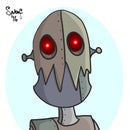Introduction: Sew Your Own Octopus!
If you're anything like me, you love octopuses. And I finally bit the bullet and designed a pattern to make my own! It took some time and a lot of, uh, interesting results... But I did it in the end! I also made a tiny version, 1/8th the size of the original Goober, and both patterns will be made available here.
Supplies
Fabric (I used polar fleece, if you use a woven fabric you will need to add a seam allowance; fleece doesn't fray at all and I was therefore able to sew with a very tiny seam - you'll also need to be extra careful about fraying if using safety eyes, and the eye pieces that provide an iris around the safety eye will not work),
Scissors,
Needle (if using polar fleece, a smaller needle is easier),
Thread,
Clips or pins if desired,
Safety eyes or buttons (these patterns have slits where the eyes go, leave these holes out if you intend to use buttons) (I always opt for safety eyes with metal backs, as they tend to be more durable in my experience),
Stuffing,
A thin implement for turning the arms inside-in at the end.
Step 1: Cut Your Pattern Pieces.
I love to lasercut my pattern pieces, because disability has made my hands a bit slow and painful. I've provided the SVGs I use here, split up by colour so it's easy to just throw one colour in and cut before moving on. If you prefer paper patterns, I have also provided printable PDF patterns for both big and small Goober.
When lasercutting polar fleece, the fabric often smells a bit like cat urine afterwards. This will go away in a day or so, but if you buy a lingerie bag you can run them through the washing machine if you need it gone immediately.
I take a while to sew since I hand-sew soft toys. I recommend a project bag or case. In my case, it's a little rectangular sewing bag with a handle on top that contains everything I need for whichever specific project I'm working on. That way it's easy to transport, easy to keep track of, and easy to make inaccessible to cats*.
This pattern specifically is quite repetitive, so I recommend putting something on the telly and just relaxing into it.
*also works on dogs, children, and yourself if you're like me and are likely to kick everything onto the floor by mistake.
Step 2: Attach the Eyes
Before inserting anything, make sure the right side of your fabric faces what will be the outside, i.e. where the eye will be. I will explain what the right side is in the next step.
If you're using safety eyes, this is a job of a minute or two. Simply insert the post of the safety eye through the hole in the eye piece. Next, insert it through the hole in one of the two top pieces you've cut with holes. Affix the backing to the post, repeat for the second eye, and you're done. I've provided two examples here that show how the eye piece functions as a little iris.
This will not work with a fraying fabric, however. If you're using a fraying fabric I recommend either using safety eyes in the top pieces directly, or sewing buttons directly onto the two pieces you've selected to have eyes. If you use a fraying fabric to make an iris, the edges will simply come apart.
Step 3: Sewing Instructions.
I'm going to work on the assumption that you've never sewn before, so obviously skip anything you don't need.
The first image shows a plain running stitch, which is what most people think of when they think of sewing. You put the two right sides of the fabric together. The right side of a fabric is the fabric you want to be on the outside of your finished Goober. In polar fleece, this is generally the fluffy side (as shown in the image) but in printed fabrics it may (also) show as the side on which the colours are most vibrant. Then you move the needle up and down, catching both pieces of fabric with each stitch, to attach them with the thread.
The smaller the stitches, the neater the work. Try to keep an even distance from the edge of your fabric, and again if you're using a woven fabric make sure you leave a seam allowance. Some people draw the line they intend to sew on the fabric, using tailor's chalk or pencil. This can make it easier to keep your sewing tidy.
Clips and pins are great ways to keep two pieces of fabric together while you sew them, but I find clips can be unwieldy especially when sewing small pieces like with small Goober. Instead, what I do is what's shown in the second image: I make a single stitch at either end of the seam I'm going to sew (light-blue crosses) and then divide the area between those two stitches into halves, then those into halves, and so forth depending on the size of the seam (dark blue crosses).
The advantage of basting, as it's called, is that pins and clips can shift as you manipulate the piece you're working on. They can accidentally fall off or out, and in the case of pins they can deform the fabrics - not permanently, but enough to shift your seam. And finally, basting stitches help me remember what I'm doing. I have ADHD and sometimes I just keep sewing until I realise I've gone way too far and have to unpick. If I come across a basting stitch, it reminds me to check how much I have left to do on my current seam.
Step 4: Sewing Your Goober!
In the first image, I show one of the top pieces of goober. The part of the line which is outlined in red is the part you should sew to the next piece. Make sure you place both pieces right sides together, then sew the red line.
Do this four times, until you have four quarters. Now attach the quarters together in pairs. I've found that taking your time to move from quarters to halves to a whole, makes it easier to get a tidy result in terms of how the seams look on top of Goober's head at the end.
You'll need to leave one seam partly open, in order to turn your Goober right side in at the end. In the second picture, you can see which parts to sew (in red) for this one seam. I do this on the seam that will be at the back of Goober's head, in between the seam that mirrors the one between Goober's eyes.
For the bottom pieces, I have provided another graphic. Again, make sure to check you have your right sides together before sewing anything.
The red triangle shape needs to be sewn together, which will allow the bottoms of Goober's arms to be a little bit wider than the tops. This creates a pleasing belling-out shape in the bottoms of the arms. The green line at the top of the arm piece needs to be attached to one of the crescents in the centre bottom piece. Carry on, repeating 8 times, until you have a bottom piece with all the arms sewn on and all the bottom triangles closed up.
To baste the bottom of Goober to the top, I start with the tips of each arm, then each armpit. There will be seams in the armpits (by which I mean the bits where the arms meet the body), and one seam each at the tip of the arms. I baste using the seam from the top, but when sewing along the seam later I go over each seam twice, double-stitching it for safety.
Next, lining up the edge of the bottoms of the arms with the tops of the arms may seem impossible as the bottoms are wider than the tops. However, the circumference of these pieces is identical. Again, baste by halving the distance, flattening the seams so they match up. Then halve that distance again, and carry on until you're confident. Sew along the entire seam.
Step 5: Finishing Touches.
Turning Goober right side in can take a while. It's important to be patient, because if you're too rough you can damage the stitching you've worked so hard on.
Use a pencil or similar implement, to slowly turn each arm. When you finish, let the tip of the arm protrude through your turning hole in the back of Goober's head. Repeat 8 times, curse octopuses for having so many arms. Accuse them of showing off. Mock them for being edgelords about how many arms they have. Wail, gnash your teeth. Curse the universe for making you, and making octopuses, and allowing you to dream, however briefly, of making an octopus.
Once the universe has finished mocking you by coldly ignoring your horror, gently and slowly pull the arms through the turning hole. Stuff each arm in turn, using smallish pieces, to ensure they stuff evenly and don't become lumpy. The pencil can help again.
Next, attach your thread to the inside of the seam at the bottom or top of your turning hole. Make sure the needle and thread are hanging completely outside the hole, then stuff the head. You'll want to leave a little bit of room for the ladder stitch you'll need to close up the turning hole, but make sure there's plenty of compressed stuffing to fill the head once you're done.
I've provided a graphic of the ladder stitch. This is a way to close up your turning hole without showing the thread on the outside of your finished Goober. It works more or less like a corset lacing, and allows you to pull the hole shut more or less invisibly.
Once you've tied off your thread, use the tip of your trusty turning pencil to gently guide the knot into the seam where it's as out of sight as possible. Next, fluff Goober's head to evenly distribute stuffing into the gap by the turning seam.
Step 6: Admire Your Goober!
You've done it! You've sewn, turned, and stuffed every single arm! At last, you're free!
...Or are you?

Participated in the
Anything Goes Contest 2021















